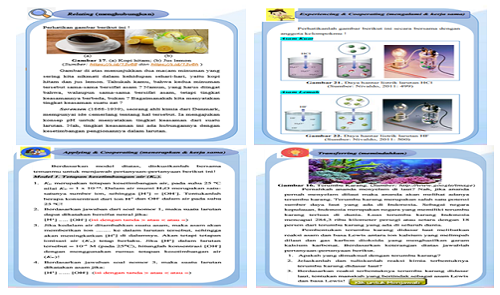
Development of the Acid and Base E-Module Based on Contextual Teaching And Learning for Class XI SMA/MA
Abstract
Keywords
Full Text:
PDFReferences
Antara, P.A., Ujianti, P.R., & Patissera, A.L. (2019). Pengaruh Model Pembelajaran Kontekstual Terhadap Kemampuan Membaca Permulaan Anak. Jurnal Mimbar Ilmu, 24(2), 223.
Asmiyunda, A., Guspatni, G., & Azra, F. (2018). Pengembangan E-Modul Kesetimbangan Kimia Berbasis Pendekatan Saintifik untuk Kelas XI SMA/ MA. Jurnal Eksakta Pendidikan (JEP), 2(2), 155.
Aiken, L. R. (1985). Three Coefficients For Analyzing The Reliability And Validity Of Ratings. Educational And Psychologycal Mesurement. 45, 131-142.
Chang, Raymond. (2010). Chemistry 10th Edition. New York: McGraw-Hill
Crawford, L. (2001). Teaching Contextually: Research, Rationale, and Techniques for improving, Student Motivation and achievement in Mathematics and sciences. Texas: CCI Publishing, Inc.
Daryanto. (2013). Strategi dan Tahapan Mengajar. Bandung: Yrama Widya
Depdiknas. (2008). Panduan Penyususnan Bahan Ajar. Jakarta: Direktorat Pembinaaan SMA
Dewi, P. Yulia A., & Primayana, K. H. (2019). Effect of Learning Module with Setting Contextual Teaching and Learning to Increase the Understanding of Concepts. International Journal of Education and Learning. 1(1), 19–26.
Groth, M., Barthe, K. G., Riemer, M., Ernst, M., Herrmann, J., Fiehler, J., & Buhk, J. H. (2018). Critical Analysis of an e-Learning and Interactive Teaching Module with Respect to the Interpretation of Emergency Computed Tomography of the Brain. RoFo Fortschritte Auf Dem Gebiet Der Rontgenstrahlen Und Der Bildgebenden Verfahren, 190(4), 334–340.
Hafsah, N. R., Rohendi, D., & Purnawan, P. (2016). Penerapan Media Pembelajaran Modul Elektronik Untuk Meningkatkan Hasil Belajar Siswa Pada Mata Pelajaran Teknologi Mekanik. Journal of Mechanical Engineering Education, 3(1), 106
Hake, R. R. (1999). Analyzing Change/ Gain Score. California: Indiana University.
Handayani, F. & Legi, W. (2016). Pengembangan Modul Kesetimbangan Kimia Berbasis Pendekatan Saintifik untuk Kelas XI SMA/MA. Journal of Saintek, 8(1), 85-97
Herawati, N. S., & Muhtadi, A. (2018). Pengembangan Modul Elektronik (E-Modul) Interaktif Pada Mata Pelajaran Kimia kelas XI SMA. Jurnal Inovasi Teknologi Pendidikan, 5(2), 180–191
Johnson, B., E. (2002). Contextual Teaching and Learning: What It Is and Why It's Here to Stay. California: Corwin Press, Inc.
Kemendikbud. (2017). Panduan Praktis Penyusunan E-modul. Jakarta: Direktorat Pembinaan SMA.
Kurniawan, C., & Kuswandi, D. (2021). Pengembangan E-Modul Sebagai Literasi Digital pada Pembelajaran Abad 21. Jawa Timur: Academia Publication.
Najuah., Lukitoyo, P. S., Wirianti, W. (2020). Modul Elektronik: Prosedur Penyusunan dan Aplikasinya. Medan: Yayasan Kita Menulis.
Nanda, K. K., Tegeh, I. M., & Sudarma, I. K. (2017). Pengembangan video pembelajaran berbasis pendekatan kontekstual kelas V di SD Negeri 1 Baktiseraga. Jurnal Edutech Universitas Pendidikan Ganesha, 5(1), 88–99.
Ngafifi, Muhammad. (2014). Kemajuan Teknologi dan Pola Hidup Manusia dalam Perspektif Sosial Budaya. Jurnal Pembangunan Pendidikan: Fondasi dan Aplikasi, 2(1), 34-47
Nugrahaeni, A., Redhana, I. W., & Kartawan, I. M. A. (2017). Penerapan Model Pembelajaran Discovery Learning untuk Meningkatkan Kemampuan Berpikir Kritis dan Hasil Belajar Kimia. Jurnal Pendidikan Kimia Indonesia, 1(1), 23–29.
Nurhasnah, & Sari, L. A. (2020). E-Modul Fisika Berbasis Contextual Teaching And Learning Menggunakan Aplikasi Kvisoft Flipbook Maker Untuk Meningkatkan Literasi Sains Peserta Didik SMA/MA Kelas XI. NATURAL SCIENCE: Jurnal Penelitian Bidang IPA Dan Pendidikan IPA, 6(1), 29–40.
Nurkolis, N., & Muhdi, M. (2020). Keefektivan Kebijakan E-Learning berbasis Sosial Media pada PAUD di Masa Pandemi Covid-19. Jurnal Obsesi : Jurnal Pendidikan Anak Usia Dini, 5(1), 212.
Nuratika, A., Utami, L., Octarya, Z. (2020). Pengaruh Pendekatan Contextual Teaching and Learning Disertai Media Audio Visual Terhadap Hasil Belajar Siswa. Journal of Research and Education Chemistry, 2(2), 56-70.
Plomp, T. (2013). Educational Design Research. Netherland: Institute for Curriculum development.
Purwanto, N. (2009). Prinsip-Prinsip dan Teknik Evaluasi Pengajaran. Bandung: Remaja Rosdakarya.
Roziyah, I. F., & Haryani, S. (2017). Peningkatan Motivasi Dan Hasil Belajar Melalui Contextual Teaching Learning Berbantuan Study Card. Jurnal Inovasi Pendidikan Kimia, 11(1), 1828–1839.
Sanjaya, W. (2010). Strategi Pembelajaran Berorientasi Standar Proses Pendidikan. Jakarta: Kencana Prenada Media Group.
Sukardi. (2012). Evaluasi Pendidikan: Prinsip dan Operasionalnya. Jakarta: Bumi Aksara.
Suryosubroto, B. (1983). Sistem Pengajaran dengan Modul. Jakarta: Bina Aksara.
Susiloningsih, W. (2016). Model Pembelajaran CTL (Contextual Teaching and Learning) dalam Meningkatkan Hasil Belajar Mahasiswa PGSD Pada MataKuliah Konsep IPS Dasar. PEDAGOGIA: Jurnal Pendidikan, 5(1), 57
Tro, Nivaldo, J. (2011). Chemistry: A Molecular Approach Second Edition. United State of America: Pearson Education, Inc.
Wijayanti, N. P. A., Damayanthi, L. P. E., Sunarya, I. M. G., & Putrama, I. M. (2016). Pengembangan E-Modul Berbasis Project Based Learning Pada Mata Pelajaran Simulasi Digital Untuk Siswa Kelas X Studi Kasus di SMK Negeri 2 Singaraja. Jurnal Pendidikan Teknologi Dan Kejuruan, 13(2), 184–197.
Yuliani, K., & Suragih, S. (2015). The Development of Learning Devices Based Guided Discocery Model to Improve Understanding Concept and Critical Thinking Mathematically Ability of Students at Islamic Junior High School of Medan. Journal of Education and Practice, 6(24), 116-128.
Zulaiha, S. (2016). Pendekatan Contextual Teaching and Learning dan Implementasinya dalam Rencana Pembelajaran PAI MI. BELAJEA: Jurnal Pendidikan Islam, 1(1), 42–60.
DOI: http://dx.doi.org/10.31258/jes.6.4.p.673-686
Refbacks
- There are currently no refbacks.
Copyright (c) 2022 Herfina Listia, Andromeda Andromeda

This work is licensed under a Creative Commons Attribution 4.0 International License.
Publisher: FKIP Universitas Riau












